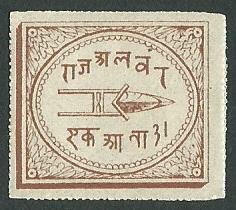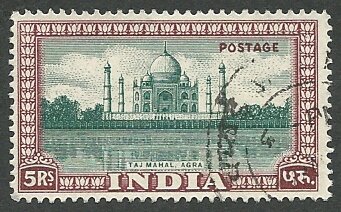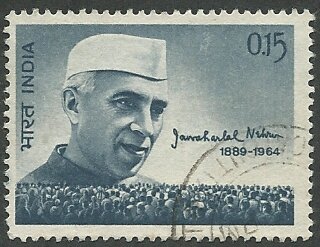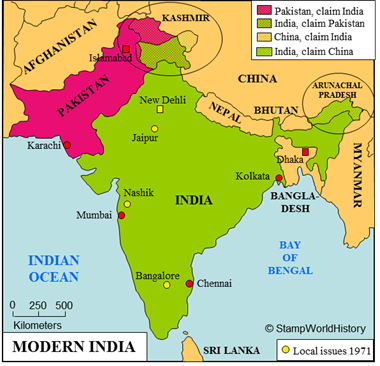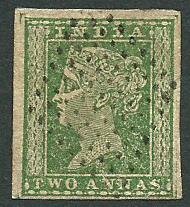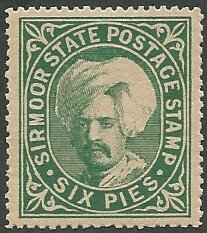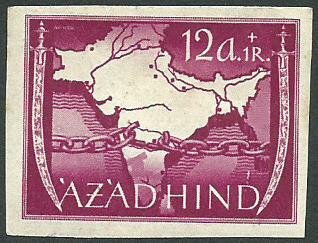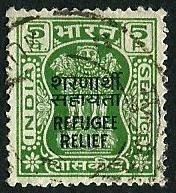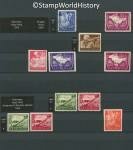भारत

India
British colony
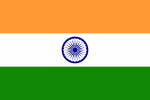
India
Republic
Quick reference
General issues: British East India Company 1854-1858, British colony 1858-1877, British colony, Empire 1877-1947, British Dominion 1947-1950, Republic 1950-Present
Country name on general issues: India, East India
Special issues:
- Scinde province 1852-1854
- Indian States 1866-1950
- China Expeditionary Force 1900-1921
- Indian Expeditionary Force 1914-1922
- British Indian occupation of Mosul 1919
- Japanese occupation of the Andaman & Nicobar Islands
- Azad Hind 1943
- Azad Hind – Andaman & Nicobar Islands 1943
- Indian forces in Korea 1953
- Indian forces in Cambodia 1954-1962
- Indian forces in Laos 1954-1965
- Indian forces in Vietnam 1954-1965
- Indian forces in Laos & Vietnam 1965-1968
- Indian forces in Congo 1962
- Indian forces in Egypt 1965
- Local Refugee Relief issues 1971
Currency: 1 Rupee = 16 Anna, 1 Anna = 12 Pies 1852-1957, 1 Rupee = 100 Naye Paise 1957-1964, 1 Rupee = 100 Paise 1964-Present
Population: British India 295 915 000 in 1900, India 345 085 000 in 1947, 1 252 000 000 in 2013
Political history India
Establishing British rule
India – located in southern Asia – in the mid 18th century consists of several kingdoms of which the Moghul empire in Dehli is the most powerful. European powers have settled in India as early as the 16th century: the Dutch, the Danish, the Portuguese, the French and the British. Initially, these powers would settle on the coast and gradually they would gain more influence further inland. In the course of the 18th century, the struggle for power in India is won by the British. The French and the Portuguese retain a number of settlements on the coast – French India and Portuguese India.
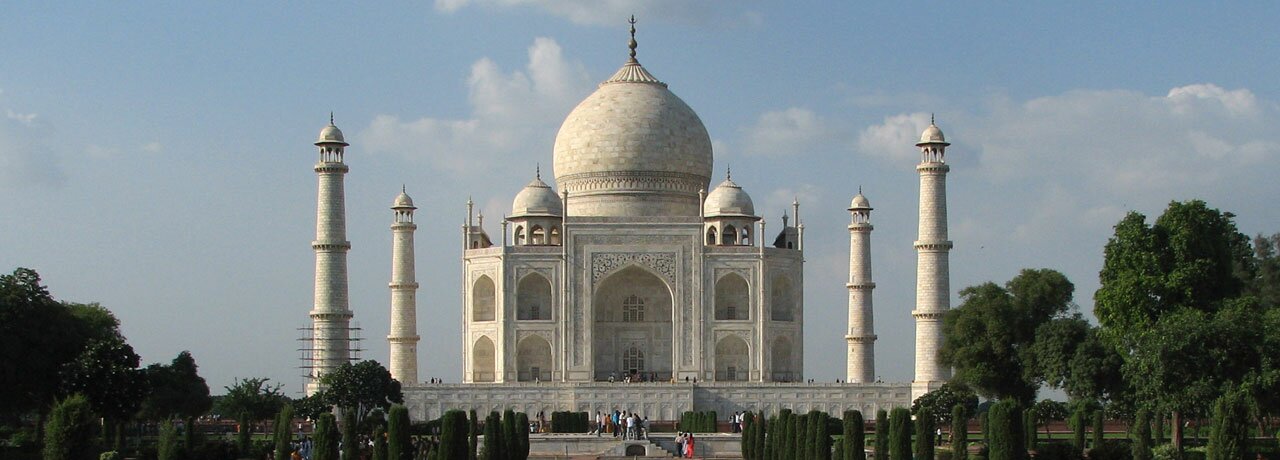
Taj Mahal
Government over the British controlled parts of India is in the hands of the British East India Company – a chartered company. At first acting largely independent, in the course of the late 18th and early 19th century the British East India Company is more and more influenced by the British government. When, in 1857, the Indians revolt against British East India Company rule, the British crown, in 1858, decides to take over. British India becomes a colony. In 1876, the British crown assumes the title of emperor to stress the superiority of the British sovereign over local sovereigns in India.
Two forms of government
In India the British establish two forms of government. First there is parts of India that are under direct British colonial administration, these parts being called British India. Second there are the princely states that are governed through the local rulers. Some of these states are middle sized countries, some are not much bigger than the estate of the ruler. There were some 600 of these princely states in India.[1]British India, strictly speaking, refers to the parts of India under direct British rule, all of colonial India often being referred to as the British Raj. In other profiles on this site I generally use British India rather than British Raj for all of colonial India to distinguish between India in colonial times and India as an independent state.
Extending British rule
In the course of the 19th century, the British further extend their control of India, both in central India and on the borders. In the west the borders with Afghanistan are defined through the Afghan wars, the last being the third Afghan War in 1919. In the east the British extend their influence into Burma in three stages between 1824 and 1885. Burma is long ruled as a province of India, in 1937 it becomes a separate colony. Other British possessions are also, at times, ruled from India: Aden on the Arabian peninsula from 1858 until 1937, British Somaliland in the Horn of Africa from 1894 until 1898 and the Straits Settlements in Malaya from 1858 until 1866.
Indian forces abroad
Forces from India, in the colonial era, are several times involved in international conflicts. In 1900, Indian forces are part of the coalition that invades China during the Boxer rebellion, the aim being to guarantee the continuation of the extraterritorial rights granted to foreign powers by the Chinese Empire. The larger part of the China Expeditionary Force is in China until 1906, a small contingent of Indian forces remains in China until 1923. During WWI, the Indian Expeditionary Force is deployed in several parts of the world. The most important deployments being the western front in Belgium and France, German East Africa, which Indian forces invade in 1916 from British East Africa, and the battle against Ottoman Empire, one of the I.E.F. divisions occupying the Mosul area in Iraq in 1918. Indian forces are again deployed in several theaters in WWII.
Free India – Azad Hind
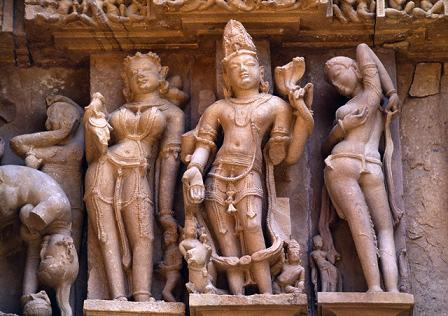
Kandariya Mahadeva temple in Khajuraho
During WWII, nationalist factions in India striving for independence seek and find the support of the Axis powers. With their support they set up the provisional government of Free India – Azad Hind – in Thailand. Azad Hind, in 1943, declares war on Great Britain. In the same year Japan transfers the government of Andaman and Nicobar Islands – occupied by the Japanese – to Azad Hind. The end of WWII also signals the end of Azad Hind. The legacy of Azad Hind is disputed, however, Azad Hind may be considered one of the elements contributing to the rise of nationalist sentiment in India, ultimately leading to Indian independence.
Gaining independence
The call for independence has been growing in India since the early 20th century, the most notable exponent of this ambition being Mahatma Gandhi. Independence is achieved in 1947. In view of the tension between the Hindu and Muslim population groups, upon independence two separate states are formed as dominions within the British Commonwealth: the predominantly Hindu India and the predominantly Muslim Pakistan. India further reduces the ties with Britain when, in 1950, it becomes a republic.
Challenges in domestic policy
The newly independent India immediately faces challenges both in its domestic and foreign policies. Internally the over 600 princely states have to be persuaded to become part of a centralized political system. Some of the princely states oppose this transition, most notably Hyderabad in central India and Kashmir in northern India. Eventually, by 1949, all princely states have accepted the republican government, although in the case of Hyderabad an armed intervention was required to achieve this goal.
The foreign settlements in India are, after Indian independence, returned to India. France transfers Chandernagor in Bengal in 1950 and the other settlements in 1954. Portugal follows suit in 1954 after an armed intervention by India. The former Portuguese settlements retain a form of self government until 1962.
Challenges in foreign policy
In its foreign policy India in confronted with a dispute over Kashmir. As soon as 1947, this dispute escalates into an armed conflict with Pakistan. In following years India and Pakistan will be engaged in armed conflict several times more. The conflict over Kashmir has not been resolved until today. Furthermore, India faces border disputes with China over Tibet in the west and Arunachal Pradesh in the east. In 1962, this leads to a short war between India and China. A war that ends in the status quo ante bellum. Like the issue with Pakistan, the conflict with China has yet to be resolved.
International involvement
India intervenes several times in internal conflicts in the region: in 1987 on the Maldives and in 1987 and 1990 on Sri Lanka. Internationally, India is an active participant in United Nations peacekeeping operations. Among these:
- The United Nations Command in Korea – an international coalition formed in 1950 under auspices of the United Nations after the North Korean invasion of South Korea. The engagement of the Command in the conflict between 1950 and 1953 is both military and humanitarian. The Command remains active in Korea to supervise the cease fire agreement from 1953 until 1978.
- The International Control Commission – established by the United Nations in 1954 to supervise the implementation of the Geneva Agreements that ended the First Indochina War. The Commission is active in Cambodia, Laos and Vietnam until 1973.
- The United Nations Organization in Congo – active in Congo to appease the warring factions after Congo has gained independence from Belgium in 1960. The Organization is active in Congo until 1964.
- The United Nations Emergency Force – established to supervise the cease fire agreement after the Suez crisis in 1956 in Egypt, more specific in the Sinai and Gaza. The Emergency Force will be in the area until the Six Day War in 1967 when Israel occupies both the Sinai and Gaza.
Postal history India
General issues
In India, several princely states had set up postal services well before the British started to set up their postal system. The British built on these already existing postal services. The first stamps are issued by the governor of the Scinde – later called Sind – district in 1852. These issues being a circular seal inscribed ‘Scinde District Dawk’ and showing the logo of the British East India Company. Dawk is the name of the already existing postal system in the district. In 1854, the British East India Company issued its first stamps for general use, inscribed ‘India’. As the British crown took over the government in India in 1858, the issues of the British East India Company are, in 1860, superseded by issues of the colonial administration. These issues are initially inscribed ‘East India’ rather than ‘India’ which is used again when India is proclaimed an empire in 1876.
Feudatory and convention states
The princely states in India have the right to issue stamps of their own. A distinction is made between feudatory states and convention states. Feudatory states may issue stamps that are valid only for internal use. The convention states are named after the convention that these states have signed with the British postal authorities. Based on this convention – through which the states conform to a number of requirements of the British postal administration – the stamps issued by the convention states are valid in all of India. Some 35 princely states have issued stamps as feudatory states only, 4 as convention states only and 2 first as feudatory and later as convention states.
The feudatory states provide a wide range of very different issues. For one thing, the feudatory states have issued stamps at very different times. Some have issued stamps for a longer period of time, such as Hyderabad that has issued stamps from 1869 to 1950. Others have issued stamps only for a short period of time, such as Rajpipla that issued stamps in 1880 only or Jasdan that issued stamps in 1942 only . Furthermore, the issues differ greatly in quality. Some are rather crude designs and prints, others have a quality that can meet any international standard. Many issues only bear the local script, thus making identification sometimes a challenge. Finally, many forgeries of these issues exist.
The issues of the convention states are much more standard due to the requirements of the British postal administration. All issues of the convention states are overprints on the stamps of India. The overprint being the name of the state in English and/or Hindi.
For a full list of feudatory and convention states please refer to the table next to the map of the British Raj.
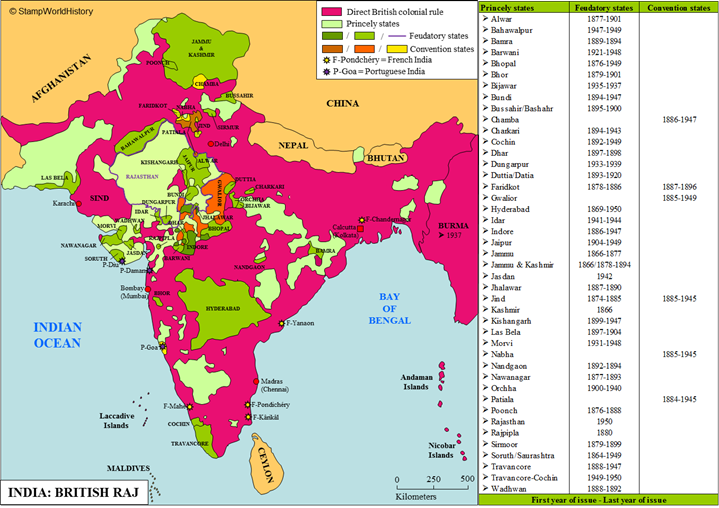
Please click on the image to enlarge, click here for the PDF version of the image
Offices abroad
The Indian postal service had a widespread network of offices abroad. A closer look:
- Some British possessions were, for a time, governed as part of the British Raj and as such the postal service was part of that of India: Aden from 1858 until 1937, British Somaliland from 1887 until 1907 with an office also in what was to become Italian Somaliland and the Straits Settlements[2]Malacca, Penang and Singapore until from 1867 the Straits Settlements issued stamps of their own.
- In other British possessions not governed as part of the British Raj, the Indian offices preceded the establishment of a regular local postal service, such as the offices in Mombasa and Lamu, British East Africa from 1890 until 1895, that in Sudan from 1887 until 1894 and that in Zanzibar from 1868 until 1869 and again from 1876 to 1895.
- Many offices were to be found in the Ottoman Empire. The Indian offices in the Ottoman Empire covered the Middle East part of the Ottoman Empire and were thus complementary to the British offices in the Levant that covered the western part of the Ottoman Empire. The Indian offices in the Ottoman Empire closed in 1914 – like most offices in the Levant.
- In those parts of the Ottoman Empire that had become British protectorates during WWI – Bahrain and Kuwait – and in some neighboring states – Muscat and the Trucial States – the Indian post offices existed to a much later date, many to be continued in 1947 as part of the postal service of Pakistan and, in 1948, to be transferred to the British Postal Agencies in Eastern Arabia. These again would finally be transferred to the local postal services, some of which were not set up until the mid 1960’s.
- Many offices also existed in Persia, a country in which the British had significant influence – although shared with the Russians. The offices in Persia[3]The current Iran. – all closed in 1923.
- In Nepal an office, initially for consular mail but from 1878 open to the public, existed in Kathmandu where Indian stamps were used from 1854. International mail from Nepal was franked with Indian stamps until Nepal joined the UPU in 1956.
- In Tibet the British opened a number of post offices in the early 20th century as part of the British policy to bring Tibet into the British sphere of influence. Tibet long being de facto independent, these offices existed until 1955 having been continued by India after it had become independent.
- Indian offices were also found in French India and Portuguese India.
Aside from the Indian offices abroad, Indian stamps were also used on Labuan, until 1867, when the issues from the Straits Settlements come into use also in Labuan.

Please click on the image to enlarge, click here for the PDF version of the image
Expeditionary Forces
As forces from the British Raj were active in several international conflicts, for some of the ‘Expeditionary Forces’, stamps were issued. First there were the issues from 1900 until 1921 – used until 1923 – for the China Expeditionary Force deployed in China to quell the Boxer Rebellion. These were Indian issues overprinted ‘C.E.F.’. Second there were the issues for the Indian Expeditionary Force that was deployed in several theaters of war during and after WWI. These stamps – used until 1922 – were Indian stamps overprinted ‘I.E.F.’. The Expeditionary Force D in 1918 occupied the Mosul area in Mesopotamia and, for use in this area, issued stamps overprinted ‘I.E.F.’D”.[4]The Indian forces consisted of seven divisions labeled A through G. The Mosul area was occupied until 1925 when it became part of the British mandated territory of Iraq.
Azad Hind
The Provisional Government of Free India – Azad Hind – that was set up with Axis support during WWII prepared stamps in 1943. Seven stamps with a surcharge to support Azad Hind were printed. Three stamps without surcharge were prepared for use on the Andaman and Nicobar Islands that – being occupied by Japan – were under nominal control of Azad Hind. The issues for the Andaman & Nicobar Islands were to supersede stamps issued by the Japanese administration on the Islands. The stamps of Azad Hind were printed in Germany but eventually never issued.[5]These issues are listed only in the Michel catalog.
Indian forces in UN peacekeeping missions
For some of the Indian forces active in United Nations peacekeeping missions stamps were issued as follows:
- The United Nations Command in Korea. Indian stamps with an overprint in Hindi reading ‘Indian Custodial Unit Korea’ were issued in 1953. The United Nation Command in Korea was active until 1978.
- International Control Commission in Indochina. Indian stamps with overprints reading ‘International Commission Cambodia‘, ‘International Commission Laos‘ and ‘International Commission Vietnam‘ were issued in 1954 for use in these respective countries. In 1965 and 1968, Indian stamps with an overprint reading ‘ICC’ were issued for use in Laos and Vietnam. The International Control Commission was active in Indochina until 1973.
- The United Nations Organization in Congo. Indian stamps with an overprint reading ‘U.N. FORCE (INDIA) CONGO’ were issued in 1962. The United Nations Organization in Congo was active until 1964.
- The United Nations Emergency Force in Egypt: the Sinai and Gaza. Indian stamps with an overprint reading ‘UNEF’ were issued in 1965. The United Nations Emergency Force was active in Sinai and Gaza until 1967.
Local refugee relief overprints 1971
In 1971, East Pakistan fought its war of independence to become the current Bangladesh. The war resulted in a large number of refugees. To support the refugees, India issued surcharge stamps, the use of which was obligatory on both general and official mail. Preceding the issue of definitives for both general and official mail in December 1971, provisional overprints were issued in November 1971. As the central postal authorities could not provide the overprints in sufficient numbers, local postal authorities were allowed to issue local, often hand stamped, overprints. The overprints would read ‘Refugee Relief’ in English and/or Hindi and exist in many types.[6]These issues are referred to by the worldwide catalogs and not all types are listed. Michel has examples of the general issues from Bangalore, Dehli, Jaipur and Nashik and for the officials of Bangalore and Nashik.
Album pages India
Album pages Indian states
← Previous page: Hong KongNext page: Indonesia →

